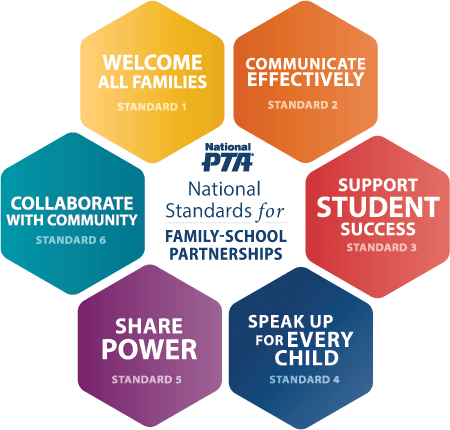What is family engagement?

Chronic absences make family engagement more important than ever
Schools throughout California are struggling with high levels of chronic absences. Many children simply are not showing up at school. One of the best strategies to turn this around is to ensure that families feel welcomed, heard, and part of a caring school community.

Heather Ippolito is President of the California State PTA (2025-27).
That’s what family engagement is all about.
Families need to know that their school cares about the success of each student — and that just two days a month of absences can deeply affect student academic success.
Many schools think they are engaging parents, but continue to have high absenteeism and disengaged families. That’s why it is more important than ever for school districts and school communities to start planning now for successful family engagement in the coming year.
Participation and perspective
I learned an important lesson a few years ago when our school site council was trying to evaluate how well the school was engaging families.
“We rock at this!”
Our principal happily crowed, “We are definitely great at communicating. We send out fliers and make calls to families — we rock at this!”
Our teachers and classified staff shook their heads. One brave teacher spoke up and said, “I don’t know. We do send a lot of things out, and I’m using the new text system the district purchased for us, but I’ve noticed that not every family is using it, so I think we are only doing OK in this area.”
The parents in the room looked at each other in disbelief, “We are not doing nearly enough in this area. Communications are only in English and Spanish, and we have lots of families who speak other languages.” Another piped up, “Nobody ever asks us for feedback — it’s always just pushing information out. We have a lot of work to do in this area!”
Successful family engagement requires the participation and perspective of all members of our school community.
Training for Family Engagement
Why is this gap in the execution of family engagement so wide? Sadly, neither educators nor administrators receive training in the why and how of family engagement. They generally believe that it is supremely important to student success, but lack the methods to do it effectively.
I am a credentialed elementary school teacher who recently returned to school to get my administrative credential. I can unfortunately report that my training in family engagement was reduced to a chapter of a book and possibly a few discussion questions. Districts are largely left to their own devices to train their teachers and school staff about ways to engage families.
Why do schools fail to effectively engage parents?
The research is clear that family engagement helps kids succeed, so why do so many schools fail to really engage families?
- Training: Educators are not trained in ways to partner with families.
- Responsibility: Family engagement is not seen as a responsibility of all staff.
- Regularity: Educators do not annually assess their efforts.
- Strategy: School districts leave it up to each school site and don’t provide a research-based strategy for schools to use.
- Input process: There is no thoughtful planning that involves the input of the diverse parent communities at the school.
- Leadership: In many districts, no one is in charge to provide oversight and suggestions.
- Missed opportunity: The LCAP requirements for family engagement are seen as paperwork rather than an opportunity to engage families.
Happily, there is a great deal of help and resources out there for parents, educators and administrators alike.
National PTA recently updated its National Standards for Family School Partnerships, integrating the perspectives of families, educators, and youth, particularly those from historically marginalized communities, and adding new resources for site administrators.
Our predominantly Latine, low-income Title I school used the tools from National PTA to help focus the conversation on what good family engagement looks like. We quickly found that we had wide swings in some of the areas and the conversations that came out of that were enlightening to everyone involved. Our principal didn’t realize that families felt like they were being talked to — never in partnership with. She was able to reconsider how she was communicating and incorporate the ideas that we came up with during that meeting.
Does your school engage with families effectively?
The table below summarizes the elements of the full rubric. For each of the standards, at what level is your school community performing? Would others agree? Try it.
|
Rubric for family engagement (Ed100 summary) National Standards for Family School Partnerships |
||||
|---|---|---|---|---|
|
Level 1: |
Level 2: |
Level 3: |
||
|
1 |
Welcome all families |
Host school-wide events for families to attend, such as community-building events, student showcases and sporting events. |
Conduct family surveys that include inquiring about families’ experiences with the school, and that assess whether they feel respected, understood, and connected to the school community. |
Ensure all teachers regularly reach out to all families to share positive news about their child. |
|
2 |
Communicate effectively |
Ensure that school-wide mass communication is disseminated in multiple ways (newsletter, email, phone blast, etc.) |
Ensure that teachers use multiple ways to reach families (email, app, phone call, etc.) |
Ensure that teachers differentiate individualized communication to each of their students’ families based on each family’s expressed preference (teacher, school- wide communication etc.) |
|
3 |
Support student success |
Communicate expectations to teachers for sharing strategies, tools and resources with families to support social, emotional, and academic learning at home. |
Prepare instructional coaches to support teachers with planning and implementing practices for sharing strategies, tools and resources that families can use to support social, emotional and academic learning at home. |
Ensure that teachers provide opportunities for families to practice using strategies, tools, and/or resources to equip them to be co-creators, supporters, encouragers, monitors, advocates and models in their child’s education. |
|
4 |
Speak up for every child |
Identify groups and subgroups of families and students historically marginalized from the school community (racial, ethnic, linguistic, socio-economic, geographic, etc.) |
Send targeted, differentiated communication to members of various groups and subgroups to learn about their perceptions of their current participation as formal or informal leaders. Survey their interest in serving in formal or informal leadership roles, and inquire about specific areas of interest. |
Learn from members of the various groups and subgroups about barriers that need to be removed. What supports do they need to be successful in informal and formal leadership roles? |
|
5 |
Share power |
Provide examples of what strong family and civic leadership looks like in practice by highlighting existing activities that families are leading or participating in. |
Acknowledge and reward student and family participation in leadership and civic engagement opportunities. |
Ensure that leadership and civic engagement opportunities reflect the culture and values of students and families. Solicit feedback from individuals engaged in family leadership and civic engagement. |
|
6 |
Collaborate with community |
As appropriate, survey students to identify the needs and assets within the community. |
Build relationships with “official” and “unofficial” community leaders to learn about the needs, assets and priorities of community partners. |
Provide staff with authority and autonomy to build partnerships with community organizations that will support family and school priorities for improved academic and socio-emotional well-being of students. |
The National Standards Leader Actions Rubric contains more detailed examples of best practices for each of the six topics above.
Our school used this rubric in our school site council (SSC) meetings and PTA meetings. Our principal brought it to her leadership meetings as well. We discussed one standard a month.
We put our plan into our Local Control Accountability Plan (LCAP) and attached funding to it so that we could see growth. We surveyed parents who were outside of the site council or PTA to get their feedback. Our principal used the standards to focus her monthly “coffee with the principal” meetings to include even more caregivers in the discussions.
Effective family engagement should look like this
The outcomes from our discussions using the rubric became the blueprint for our school. We had a clear plan of ways to welcome families to our campus, to better communicate with the families on our campus, to include them in the decision making, and to ensure that all families understood how they could help their students succeed.
When all three of these groups partnered together, our students reaped the benefits! Our test scores climbed, teacher satisfaction and retention improved, and our school became a model for others in the district. This did not happen overnight, or even easily. It was a process that still continues to this day. My child was promoted years ago.
Family engagement resources to address chronic absences
I urge all PTAs and school communities to start planning now to improve family engagement at their school with a particular focus on attendance. Even a few missed days of kindergarten in September can set up a child for academic challenges.
Attendance Works has developed strategies to reduce chronic absence at school sites and family engagement is an essential ingredient. It is also important to collect and report attendance and chronic absence data and analysis that can show reasons that students miss school. The data collection is used to activate positive supports, not punitive action.
 Heather Ippolito, President of the California State PTA (2025-27) and former Vice President for Family Engagement, is the wife of her high school friend sweetheart, Ron, and the mother of Liliana. She holds a teaching credential, an administrative credential, and two masters degrees — one in curriculum development and the other in educational administration. Heather began her teaching career in Santa Clarita, California, where she taught fifth, sixth and first grade, and also served as a district music teacher for two years. Heather has served at the unit, council, district and state levels in PTA and remains deeply proud to uphold the mission to benefit the lives of children and families across the state.
Heather Ippolito, President of the California State PTA (2025-27) and former Vice President for Family Engagement, is the wife of her high school friend sweetheart, Ron, and the mother of Liliana. She holds a teaching credential, an administrative credential, and two masters degrees — one in curriculum development and the other in educational administration. Heather began her teaching career in Santa Clarita, California, where she taught fifth, sixth and first grade, and also served as a district music teacher for two years. Heather has served at the unit, council, district and state levels in PTA and remains deeply proud to uphold the mission to benefit the lives of children and families across the state.Tags on this post
All Tags
A-G requirements Absences Accountability Accreditation Achievement gap Administrators After school Algebra API Arts Assessment At-risk students Attendance Beacon links Bilingual education Bonds Brain Brown Act Budgets Bullying Burbank Business Career Carol Dweck Categorical funds Catholic schools Certification CHAMP Change Character Education Chart Charter schools Civics Class size CMOs Collective bargaining College Common core Community schools Contest Continuous Improvement Cost of education Counselors Creativity Crossword CSBA CTA Dashboard Data Dialogue District boundaries Districts Diversity Drawing DREAM Act Dyslexia EACH Early childhood Economic growth EdPrezi EdSource EdTech Education foundations Effort Election English learners Equity ESSA Ethnic studies Ethnic studies Evaluation rubric Expanded Learning Facilities Fake News Federal Federal policy Funding Gifted Graduation rates Grit Health Help Wanted History Home schools Homeless students Homework Hours of opportunity Humanities Independence Day Indignation Infrastructure Initiatives International Jargon Khan Academy Kindergarten LCAP LCFF Leaderboard Leadership Learning Litigation Lobbyists Local control Local funding Local governance Lottery Magnet schools Map Math Media Mental Health Mindfulness Mindset Myth Myths NAEP National comparisons NCLB Nutrition Pandemic Parcel taxes Parent Engagement Parent Leader Guide Parents peanut butter Pedagogy Pensions personalized Philanthropy PISA Planning Policy Politics population Poverty Preschool Prezi Private schools Prize Project-based learning Prop 13 Prop 98 Property taxes PTA Purpose of education puzzle Quality Race Rating Schools Reading Recruiting teachers Reform Religious education Religious schools Research Retaining teachers Rigor School board School choice School Climate School Closures Science Serrano vs Priest Sex Ed Site Map Sleep Social-emotional learning Song Special ed Spending SPSA Standards Strike STRS Student motivation Student voice Success Suicide Summer Superintendent Suspensions Talent Teacher pay Teacher shortage Teachers Technology Technology in education Template Test scores Tests Time in school Time on task Trump Undocumented Unions Universal education Vaccination Values Vaping Video Volunteering Volunteers Vote Vouchers Winners Year in ReviewSharing is caring!
Password Reset
Search all lesson and blog content here.
Login with Email
We will send your Login Link to your email
address. Click on the link and you will be
logged into Ed100. No more passwords to
remember!















Questions & Comments
To comment or reply, please sign in .
LeeAnn Corral April 8, 2024 at 8:55 pm
Carol Kocivar July 30, 2023 at 3:28 pm
Zohe Garcia July 19, 2023 at 10:18 am